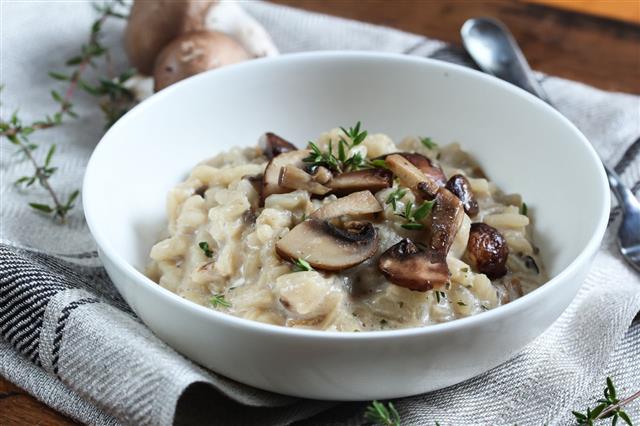
Many people shy away from making risotto dishes due to the perceived complexity of cooking Arborio rice. This article explains how to cook Arborio rice perfectly, demystifying the process and explaining the steps so that anyone can make a wonderful risotto.
Arborio rice is a traditional Italian rice that is used in dishes that usually require a creamy texture. It is a type of short-grained white rice that is the main ingredient in all risotto dishes. Due to the time and attention required to cook Arborio to perfection, risotto is often thought of as a special dish to be reserved for holidays, and avoided in daily cooking.
However, with a little background on the basic technique of cooking Arborio, everyone can learn to make impressive, flavorful risotto dishes with ease.
The first and most important step is to toast the rice grains. Many amateur chefs skip this step because it does not yield any immediately visible results and can seem unnecessary. Toasting the grains is crucial, though, because it starts the grains of rice on the process that will eventually allow them to take on the desired texture.
- In order to toast the grains, heat a pot over medium-high heat and add the desired fat (usually butter or olive oil) along with any aromatics (such as onions and garlic) that need to be cooked.
- Then add the rice to the pan, allowing it to absorb the oil. Stir constantly to prevent sticking.
- After a minute or so, the rice will begin to release a distinct nutty smell and will become hot to touch. At this point, the grains are toasted!
The remaining steps in the process consist of slowly adding liquid to the rice. This is where cooking Arborio differs significantly from cooking other types of rice. With Arborio, it is tempting to add all the liquid at once and boil, as you would do with long-grained rice. Doing this will not create the creamy texture of risotto. The texture is created by adding the liquid a little at a time, allowing the rice to absorb the liquid and release starch gradually.
The usual proportion for cooking Arborio is 4:1 liquid to rice. For example, two cups of dry rice require about eight cups of liquid. Because the liquid is added a little at a time, these measurements are approximate and can be easily adjusted depending on the texture of the rice. Traditionally, chicken stock is used as the liquid base for the rice, but any type of stock, including vegetable stock or plain water can also be used.
After the rice has been toasted, add about one cup of liquid to the pot and allow it to simmer, stirring it constantly until the rice has absorbed all of it. Remember, patience is the key to success! At first, it may seem that rice will not absorb it all, but it will if you wait and keep stirring. It is important not to boil the liquid at too high a temperature, since it can affect the end result. When the first cup of liquid is absorbed, add another 1/2 cup and repeat the process, stirring until all the liquid has been absorbed. Keep adding liquid 1/2 cup at a time until the rice is cooked. Do not worry about adding more or less liquid than originally intended ― it is more important to pay attention to the texture of the rice.
Perfectly cooked Arborio should be creamy in texture, but not soggy. A common mistake is to cook the Arborio for too long, letting it absorb as much liquid as possible. This results in rice that is overcooked and a risotto with a texture like baby food. In order to avoid this, constantly taste the Arborio for texture. When the rice is creamy and soft but with a little firmness remaining in the center, the rice is done. When you bite into the rice, your teeth should meet with some resistance. If the rice is crunchy, keep cooking.
What’s next? Enjoy the delicious meal! Hope the instructions given above will help you to make the perfect Arborio rice, and some perfect risotto dishes along with it. If you don’t get it right the first time, don’t get disheartened. It always takes a few tries to get this process just right. When you finally get a hang of it, start experimenting with your risotto dishes by adding different ingredients and combining flavors in whatever way it suits you. The beauty of risotto is its versatility. From plain Parmesan risotto to exotic Truffle risotto, the possibilities are endless.





